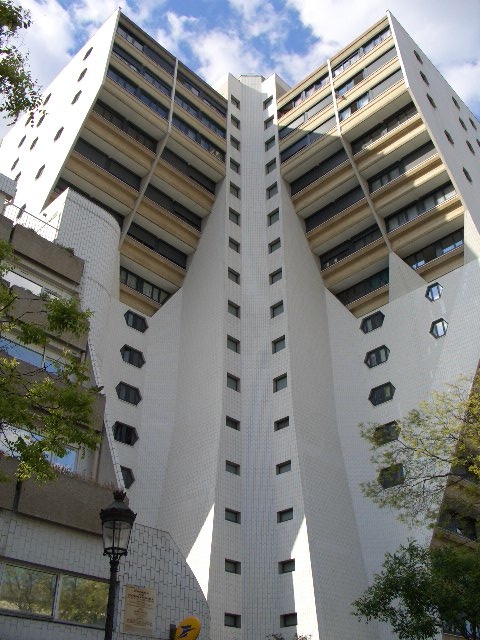The main hall of 104 Centquatre is a vast space. Concrete floor, skylight open to the cerulean-grey patchwork above, red brick, iron beams. Dancers of a world of styles – hip-hop, tango, salsa – are toiling joyously in the natural light that pours through that transparent roof. It’s hard to believe this building was once home to the city undertaker service, where up to 1400 people organised 150 funerals a day, where first horses then motorised hearses were accommodated on a site the size of Place de la République. The 1873 building has, since its rebirth in 2008, housed rehearsal and performance spaces, a start-up incubator, bookshop, cafés and vintage boutique Emmaüs. It’s a world unto itself – from the Open Wall neon installation by Pascale Marthine Tayou in the arched floor-to-ceiling glass frontage as you enter to the tucked-away Café Caché.
Paris does urban renewal with style, and this is the second example of it on our Saturday afternoon ramble through the 10th, 18th and 19th arrondissements to Aubervilliers, a copy of L’Autre Paris in hand.
When J and I meet at Gare de l’Est at 3pm, we have it firmly in mind that we’ll be finished and settled with beers in hand at Le Supercoin by six at the latest. Not so fast. Turns out perhaps we walk slowly, or take too long over coffee, or there are just too many things to see on Nicolas Le Goff’s second itinerary in the book to rush things.
Our first cool discovery is behind a high wall over the road from the 19th-century railway station, one of Paris’s six main hubs and the departure point for the first Orient Express to Istanbul (thank you, Wiki, for that titbit). The station façade is gorgeous. But more lovely in its way is the garden of Café A in the Maison de l’Architecture. Too late for lunch, too early for coffee. We snap a couple of pictures, take a look at the menu and promise to return another day.

Right, to serious navigating, wandering, wondering and getting under the skin of a new part of town. (Sorry, 20th, you’ll have to sit this one out.)
We cross the forecourt of the station, up horseshoe-shaped stairs, over an iron bridge next to an old viaduct, around the corner to find the coloured façade of Collectif 23 is no more. We stand at the gate, making friendly noises to the dog on the other side. Eventually, a nice chap comes to ask if he can help us. I explain we’re doing a tour and hold up the book. He looks puzzled, then amused as he reads the entry that mentions this art collective squat – the mural was painted over, he says – and invites us in to see their latest photography exhibition, of women fighters during the Balkans conflict.
Onwards. Through the Indian quarter, past an incense-scented temple, piles of shoes at the door, to La Halle Pajol, our first repurposed utopia. The former mail exchange depot (built 1926) is now, yes, a cultural centre and 330-bed youth hostel. Its roof also supports Paris’s second largest collection of solar panels. We find a table at Les Petites Gouttes’ leafy terrace and order coffee (for me) and a house-brewed IPA (for J).
Breather over, next stop is the Marché La Chappelle on rue de l’Olive. The covered market, which stays open until 7.30pm most days, has immaculate stands of produce, fish, meat and cheese. I love French markets – rabbits with organs neatly on display, chickens with feet and head intact, pungent cheese, fresh oysters to be devoured standing up. Nearby En Vrac sells wine by volume – you can take your bottle and refill for just 3€.
Due to my inability to navigate and read instructions at the same time we’re halfway across the power-blue bridge over the train tracks before I realize we’ve skipped a garden or two. Regardless, we continue to the Jardins d’Eole, which stretch along the railway with basketball courts, lawns and a lovely view of the Sacré-Coeur off in the distance. It’s a green oasis between transport infrastructure and high-rise apartment developments and very popular, it seems.

Around the corner, through a neighbourhood vide grenier in full swing, we stop to gape at the Orgues de Flandre, a monumental 1970s housing development. From there, it’s five minutes to Centquatre.

Deciding not to have another stop, at Café Caché, we leave arts central and walk along Paris’s longest street art fresco to the new Gare Rosa-Parks. (It links to Saint-Lazare in seven minutes!) The pedestrian/cyclist thoroughfare takes us to Square Claude-Bernard, then over the Périphérique via a curvy wooden bridge, glancing right at the Forêt Linéaire but a bit too weary to explore further.

Our final destination is the canal and the free shuttle ferry from enormous shopping centre Le Millénaire to the Corentin-Cariou métro station, where our “official” itinerary ends. The ferries come every 12 minutes and are a novel way to travel.
So, at nearly 8pm, we finally reach Le Supercoin, a close-to-perfect neighbourhood bar that specializes in craft beer. Oh yes. We get two demis of Rhythm’n’Blues, a smoked rye IPA from local O’Clock Brewing. At 7.5 per cent alcohol, it’s a big beginning but, hey, we’re been walking. And, oh yes, she’s a lovely drop, with clear notes of smoke and pleasing bitterness. We discuss barley wine and the merits of ambrée versus IPA, all the while continuing with a mini degustation (and nibble a complimentary crêpe complète). Our next beers, shared, in bottle not pression, include a coffee number from Brasseurs du Grand Paris that we agree would make a cracking biramisu.
Sweet.














